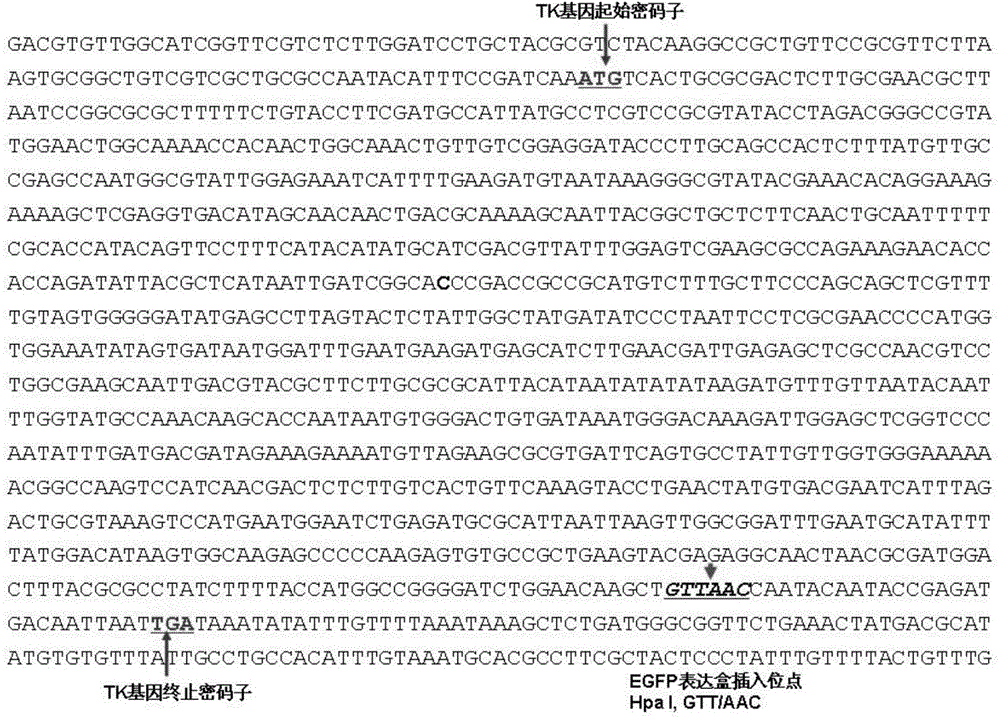Duck plague virus recombinant vaccine strain rDEVTK-EGFP for expressing enhanced green fluorescent protein genes and constructing method and application therefore
A green fluorescent protein, enhanced technology, applied in the field of recombinant virus vaccine strain, recombinant duck plague virus strain rDEV TK-EGFP and its construction, can solve the problem that the recombinant virus construction of foreign genes has not been reported and the like
- Summary
- Abstract
- Description
- Claims
- Application Information
AI Technical Summary
Problems solved by technology
Method used
Image
Examples
Embodiment 1
[0033] The construction of embodiment 1 transfer vector
[0034] According to the DEV viral genome TK gene sequence and its flanking sequence (GenBank accession number is AY963569), a pair of primers were designed using Oligo 6.0 software, and the primer sequences are as follows:
[0035] T1 (upstream): 5'-GACGTGTTGGCATCGGTTC-3'
[0036] T4 (downstream): 5'-AAACAAATAGGGAGTAGCGAAGG-3'
[0037] First use primers T1 (upstream) and T4 (downstream) to amplify the DEV TK gene and its flanking sequence (shown in SEQ ID NO: 1), and clone it into the pMD18-T Simple vector to construct plasmid pTK; The EGFP expression cassette (shown in SEQ ID NO: 2) of the sCMV promoter was inserted into the Hpa I site in the vector pTK ( figure 1 shown), the transfer vector pTK-EGFP was constructed. Wherein, the sCMV promoter is derived from the pCS2+ plasmid, and Hind III and Stu I restriction endonuclease sites are added at both ends of the EGFP gene during amplification, through which EGFP can ...
Embodiment 2
[0038] The extraction of embodiment 2 duck plague virus genome
[0039] Inoculate DEV Clone-03 cytotoxicity at an MOI of 0.001 in a 5mL cell flask covered with a CEF monolayer (the preparation of chicken embryo fibroblasts refers to the operation of "Principles and Techniques of In Vitro Culture" (Xue Qingshan, 2001)), 37°C Adsorbed for 2 hours, discarded the virus solution, and replaced the DMEM cell maintenance solution (containing 2% FBS), and when the cytopathy reached 80% to 90%, discarded the cell maintenance solution, and added cell digestion solution (1860 μL STE; 100 μL 10% SDS; 40μL proteinase K 20mg / mL), digest overnight at 37°C, add an equal volume of phenol for extraction once, an equal volume of phenol chloroform (1:1) for extraction once, add an equal volume of chloroform for extraction once; add 1 / 10 volume of NaAC (3M , pH5.2), 2.5 times the volume of absolute ethanol, placed at -20°C for precipitation overnight, centrifuged at 4°C for 15 minutes, after air-dr...
Embodiment 3
[0040] Example 3 Transfection
[0041] Day 1: Prepare cells
[0042] The CEF cells were subcultured in advance and spread in 5mL cell flasks, cultured in a 2% constant temperature incubator at 37°C.
[0043] Day 2: Transfection
[0044] (1). Change the cell culture medium 3-4 hours before transfection
[0045] (2). Transfection system: Solution A: 18 μL 2M CaCl2, 10 μg DNA (the ratio of transfer vector to viral genome is 3:1), add deionized water to make up the volume to 150 μL. Solution B: 150μL 2×Hepes Buffered Saline (HBS)
[0046] (3). Use a pipette to add liquid A to liquid B drop by drop. While adding liquid A, use another pipette to slowly blow air into liquid B. This process should be completed within 1-2 minutes.
[0047] (4). Incubate the A and B mixture at room temperature for 30 minutes.
[0048] (5). Add the mixed solution into the cell culture medium.
[0049] (6). Place the cells in a 2% constant temperature incubator at 37° C. to continue culturing.
[0...
PUM
 Login to View More
Login to View More Abstract
Description
Claims
Application Information
 Login to View More
Login to View More - R&D
- Intellectual Property
- Life Sciences
- Materials
- Tech Scout
- Unparalleled Data Quality
- Higher Quality Content
- 60% Fewer Hallucinations
Browse by: Latest US Patents, China's latest patents, Technical Efficacy Thesaurus, Application Domain, Technology Topic, Popular Technical Reports.
© 2025 PatSnap. All rights reserved.Legal|Privacy policy|Modern Slavery Act Transparency Statement|Sitemap|About US| Contact US: help@patsnap.com



